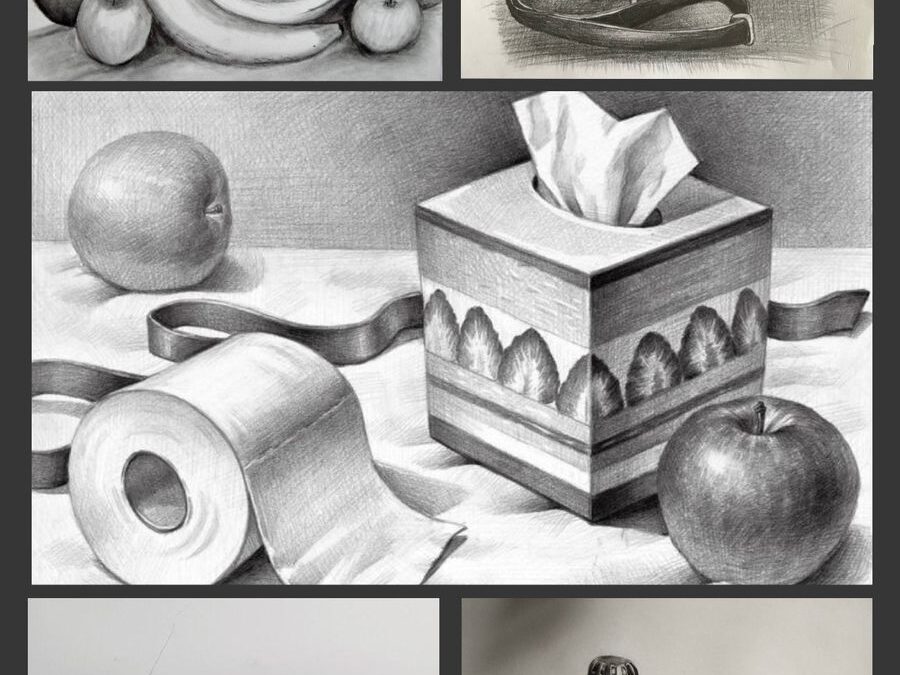
by Shravani | Dec 14, 2020
Our curated Still Life sketching course offers a structured curriculum spanning 16 days, covering a wide range of topics to build a solid foundation in sketching and pencil shading in Still Life. Here’s a glimpse of what you can expect
1. Fundamental Drawing Skills
– Basic Shapes:* Understanding how to deconstruct objects into basic geometric shapes to simplify drawing.
– Proportions and Perspective:* Techniques for maintaining accurate proportions and creating a sense of depth and space.
2. Observation and Analytical Skills
– Detail Recognition:* Training to observe and replicate fine details and textures.
– Visual Analysis:* Developing the ability to analyze and compose objects in a balanced and aesthetically pleasing manner.
3. Light and Shadow
– Light Source Identification:* Learning to identify the source and direction of light.
– Shading Techniques:* Techniques such as hatching, cross-hatching, and stippling to create realistic shading and depth.
-Understanding Values:* Differentiating between light, mid-tone, and dark values to enhance the three-dimensional quality of sketches.
4. Contour and Line Quality
– Contour Drawing:* Techniques for capturing the outline and major features of objects.
– Line Variation:* Using different types of lines (e.g., thick, thin, continuous, broken) to convey texture and form.
5. Texture and Detail
– Texture Representation:* Methods for depicting various textures like smooth, rough, shiny, and matte.
– Fine Detailing:* Adding intricate details to enhance realism.
6. Composition and Layout
– Arrangement:* How to effectively arrange objects in a composition.
– Balance and Harmony:* Creating a harmonious layout that guides the viewer’s eye through the sketch.
7. Material Handling
– Pencil Techniques:* Proper use of different grades of pencils (HB, 2B, 4B, etc.) for various effects.
– Eraser and Blending Tools:* Using erasers for highlights and blending tools (like stumps or tissues) for smooth shading.
8. Creative Expression
– Personal Style:* Encouraging the development of a unique artistic style.
– Expressive Techniques:* Experimenting with different techniques to convey mood and emotion.
9. Problem Solving
– Troubleshooting:* Identifying and correcting common drawing mistakes.
– Adaptability:* Learning to adapt techniques to different subjects and challenges.
10. Artistic Patience and Discipline
– Focus and Patience:* Building patience and focus through detailed and sustained drawing practice.
– Regular Practice:* Understanding the importance of regular practice to improve skills over time.
By the end of the course, students will have a comprehensive understanding of still life sketching, equipped with the skills to create detailed, realistic, and expressive artworks.
Age: 10+ years and Adults
Venue: Online classes on Zoom
Fee: Rs 2500 per month
For registration, whatsapp on +91 99000 52747
Testimonials by students of previous sketching batch https://www.instagram.com/p/CBmgBpsJvKY/?utm_source=ig_web_copy_link
Note: Recordings of the sessions will be available in case someone is unable to attend the classes in between.
To stay updated with the sessions, join WhatsApp group with the link https://chat.whatsapp.com/CP1RliwfMNdDZnoCJaclOn
About Bloom and Grow:
Bloom & Grow facilitates artist-led virtual and offline workshops for individuals and for corporates across the world.
